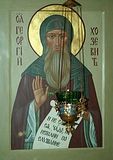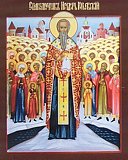 Afterfeast of the Theophany.
Afterfeast of the Theophany.  St. George the Chozebite, abbot (7th c.).
St. George the Chozebite, abbot (7th c.).  St. Domnica of Constantinople (ca. 474).
St. Domnica of Constantinople (ca. 474).  St. Emilian the Confessor, bishop of Cyzicus (9th c.).
St. Emilian the Confessor, bishop of Cyzicus (9th c.).  St. Gregory, wonderworker of the Kiev Caves (1093).
St. Gregory, wonderworker of the Kiev Caves (1093).  St. Gregory, hermit of the Kiev Caves (13th c.-14th c.).
St. Gregory, hermit of the Kiev Caves (13th c.-14th c.).  New Hieromartyr Priest Isidore and 72 companions at Yuriev (Dorpats) in Estonia, slain by the Latins in 1472 (1472).
New Hieromartyr Priest Isidore and 72 companions at Yuriev (Dorpats) in Estonia, slain by the Latins in 1472 (1472).
Hieromartyr Carterius of Caesarea in Cappadocia (304). Martyr Julian and his wife Basilissa, and with them Martyrs Celsius, his mother Marcianilla, Anastasius, the priest Anthony, seven brothers, and twenty prison guards, of Antinoe in Egypt (283-305). Hieromartyr Theophilus, deacon, and Martyr Helladius, in Libya (4th c.). St. Elias the Wonderworker, of Egypt (4th c.). Martyr Abo the Perfumer, of Baghdad, at Tbilisi, Georgia (786). St. Paisius of Uglich (1504).  St. Pachomius of Keno Lake (16th c).
St. Pachomius of Keno Lake (16th c).
St. Severin, bishop of Cologne (ca. 397). St. Atticus, archbishop of Constantinople (425). St. Severinus, spiritual leader of Roman Christians during the Germanic invasions (southern Germany and northern Austria) (482). St. Theodore of Constantinople (ca. 595). Holy Virgin Gudula of Brussels (659). St. Erhard, bishop of Regensburg (Bavaria) (ca. 700) St. Cyrus, patriarch of Constantinople (714). St. Pega, hermitess, of Peakirk (ca. 719). St. Gregory of Ochrid, bishop of Moesia (1012). St. Macarius (Macres) of Vatopedi, Mt. Athos (1431). St. Agatho, monk, of Egypt (5th c.).
Repose of Elder Isaiah of Valaam (1914) and Mother Alexandra (Princess Ileana), foundress of the Monastery of the Transfiguration (Ellwood City, Penn.) (1991).
Saturday after Theophany. [Eph. 6:10–17; Matt.
4:1–11]
The Apostle clothes Christians in the whole armour of God.
It is appropriate that this follows the previous lesson.
For, if someone, heeding the call of God, has taken on the
beginning of a new life through God’s grace,
providing for his own part all
diligence (II Pet. 1:5), then he must not
expect to rest on his laurels, but rather to struggle. He
has left the world—for that the world will begin to
press him. He was saved from the power of the
devil—the devil will chase after him and set snares
before him, to throw him off the path of good and drag him
back to his domain. He has denied himself, denied
selfishness together with a whole horde of passions. But
this sin living in us will not suddenly relinquish its
free and untrammelled existence as we live in
self-pleasure, and every minute it will attempt under
various pretexts to establish once more the same life
routine that so richly filled and fed it earlier. These
are three enemies, each with innumerable hordes; but the
commander-in-chief is the devil, whilst his closest
helpers are the demons. They run the show in a sinful
life—the opponents of a spiritual life. That is why
the Apostle arms the Christian against them as if there
were no other enemies at all. He says: we wrestle not
against flesh and blood, but against principalities,
against powers, against the rulers of the darkness of this
world, against spiritual wickedness in high places
(Eph. 6:12). If they did not exist, perhaps battles would
not exist either. Likewise, as soon as they are repelled
and struck down, it takes nothing to repel and defeat the
others. So each of you look to see where you need to
direct your arrows, or at least look to see from which
side you particularly need to defend yourself. Then,
defend yourself! The Apostle prescribed several weapons;
but all of them have power only through the Lord. That is
why experienced spiritual fighters have passed on to us
this instruction: “Strike the enemy with the name of
the Lord Jesus!”


![]() Afterfeast of the Theophany.
Afterfeast of the Theophany. ![]() St. George the Chozebite, abbot (7th c.).
St. George the Chozebite, abbot (7th c.). ![]() St. Domnica of Constantinople (ca. 474).
St. Domnica of Constantinople (ca. 474). ![]() St. Emilian the Confessor, bishop of Cyzicus (9th c.).
St. Emilian the Confessor, bishop of Cyzicus (9th c.). ![]() St. Gregory, wonderworker of the Kiev Caves (1093).
St. Gregory, wonderworker of the Kiev Caves (1093). ![]() St. Gregory, hermit of the Kiev Caves (13th c.-14th c.).
St. Gregory, hermit of the Kiev Caves (13th c.-14th c.). ![]() New Hieromartyr Priest Isidore and 72 companions at Yuriev (Dorpats) in Estonia, slain by the Latins in 1472 (1472).
New Hieromartyr Priest Isidore and 72 companions at Yuriev (Dorpats) in Estonia, slain by the Latins in 1472 (1472). ![]() St. Pachomius of Keno Lake (16th c).
St. Pachomius of Keno Lake (16th c). 
















